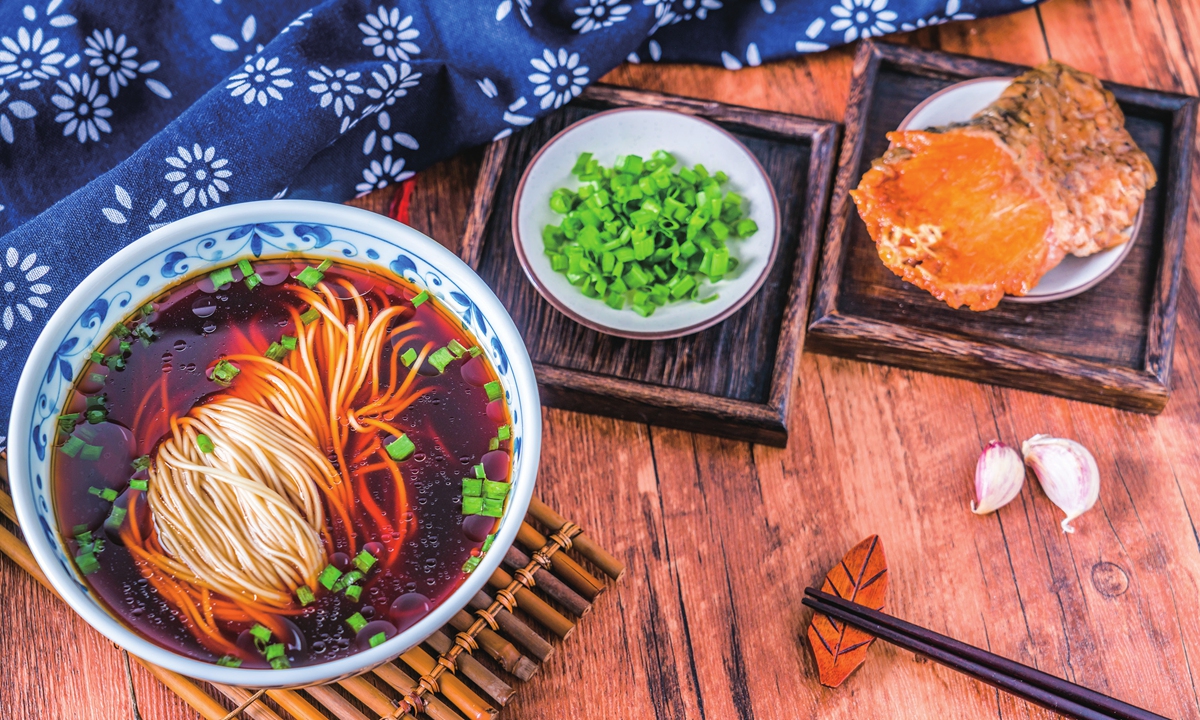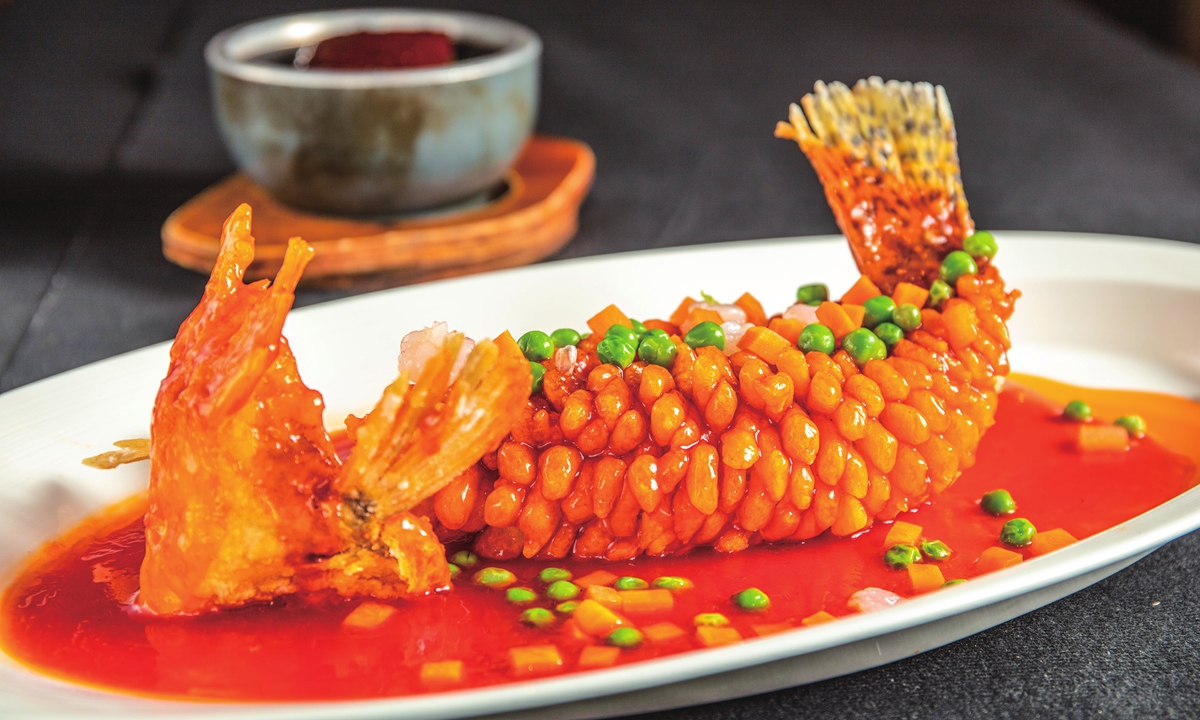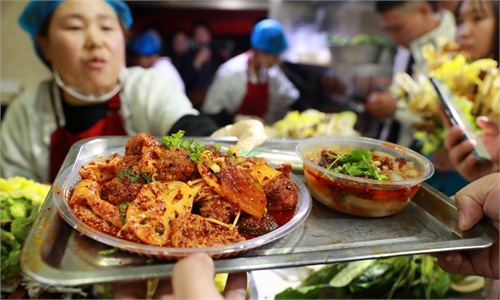ARTS / CULTURE & LEISURE
Unveiling the refined style of Suzhou recipes
Exquisite taste

Suzhou noodles Photo: VCG

The squirrel-shaped mandarin fish Photo: VCG
Suzhou, located in East China's Jiangsu Province, is known as a "heaven" in Chinese history for its rich natural resources, picturesque landscape, economic prosperity, and culinary heritage.
Dating back to 4,500 BC, Suzhou's food processing history is evident in archaeological finds of grains, animals, plants, tools and containers. After thousands years of development, Suzhou's cuisine took shape, acquiring distinctive characteristics especially during the Ming and Qing dynasties (1368-1911).
This culinary tradition belong to a branch of the Huaiyang Cuisine, one of the four major cuisines in China and today it has developed into six categories encompassing a wide array of dishes, snacks, pastries, cakes, preserved dishes and condiments.
Fresh ingredients
Suzhou cuisine is renowned for its emphasis on fresh ingredients and a delicate texture. Thanks to its surrounding fertile land, Suzhou people have the advantage of eating fresh vegetables all year around.
It is said that if some aged people missed certain seasonal food, they would lament as if "things were not going well in their life." Since it is surrounded by rivers and lakes, Suzhou boasts rich aquatic resources, such as the white fish and the white shrimp from the Taihu Lake, and the hairy crabs from the Yangcheng Lake.
Locals pay particular attention to keeping the original flavor of their produce.
Whether they stew, boil, steam, simmer, or stir-fry food, they always take a meticulous control of the heat to ensure dishes taste fresh, tender and smooth.
As Suzhou has a humid and mild climate, its locals eat light, and favor sweet and sour taste.
For example, in cooking spare ribs, the selected smaller ribs are usually deep-fried and braised with sugar and vinegar resulting in a delicate sweet and sour taste. A similar process characterizes the making of sweet and sour pork, a dish appreciated worldwide.
Elaborate craftsmanship
A standout dish in Suzhou cuisine is the squirrel-shaped mandarin fish, or Song Shu Gui (or Jue) Yu in Chinese.
This is a culinary masterpiece that often features in banquets in southern China and traces its origins to a chance encounter with Emperor Qianlong during the Qing dynasty (1644-1911).
It is said that when Qing Emperor Qianlong made a private visit to the southern part of China, he arrived at a restaurant in Suzhou called the Pine and Crane Tower.
Extremely hungry, he happened to see a fish on the table, so he ordered the chef to cook it right away.
Facing such a distinguished guest, the chef suddenly came up with an original idea.
When the dish was done, the emperor enjoyed its taste immensely. Since then, the cooking method of this dish has been kept and passed down for hundreds of years.
This delicacy demands intricate preparation, from delicately carving the fish to preserving it with seasoning for a while, and to enveloping it in a paste made from yolk and flour.
Then it is deep-fried until is turns golden brown in color and crispy yet tender dish in taste. Finally, it is accented by a tantalizing sweet and sour sauce.
Since the cooked fish is shaped like a squirrel, it is named and makes a delectable and typical dish in Suzhou.
Delicate variety
Visitors to Suzhou would also be amazed by its different kinds of snacks, such as noodles, dumplings, pastries, cakes and candies. Among them, Suzhou noodles are one of the best representatives of local snacks, and they can best showcase the refined lifestyle of Suzhou. Different from the noodles in northern China, Suzhou noodles are fine and pliable and can be cooked in just three minutes. Then they are neatly placed in a bowl with a clear soup, affectionately known by the locals as the "soul" of the noodles.
There are two types of soup: "the white soup" and "the red soup." The white soup is made from old ducks, pork bones and old hens, while the red soup is made from fish heads, eel's bones, shrimps, pork bones and old hens, and it must be stewed for over eight hours.
To go with the noodles, dozens of toppings can be selected, such as braised pork, ribs, deep fried and marinated fish or eels, chickens, ducks, shrimps, crabs, vegetables, mushrooms and so on. If one topping is not enough, two and three more can be added.
Suzhou locals also lay strong emphasis on the procedure of having noodles. According to a Chinese gourmand, in Suzhou's restaurants, noodles should not be boiled until customers give orders to keep them fresh and chewy. As a saying goes, "a bowl of noodle soup represents a Suzhou Garden in food." For Suzhou locals, eating food is a way to enjoy life at a leisurely pace - relishing each dish as part of a slow-paced lifestyle.
Suzhou cuisine is not just about food, but an art form that has endured for centuries as well as the traditional culture of Suzhou. As time goes by, it has maintained its unique charm by preserving traditions and in recent years, integrating new elements from other cuisines of China to cater to modern palates. Just as a local diner surnamed Wu, told the Global Times: "Now it is very hard to find a restaurant dedicated solely to Suzhou cuisine, as various kinds of cuisines are always offered for people's diversified tastes."

